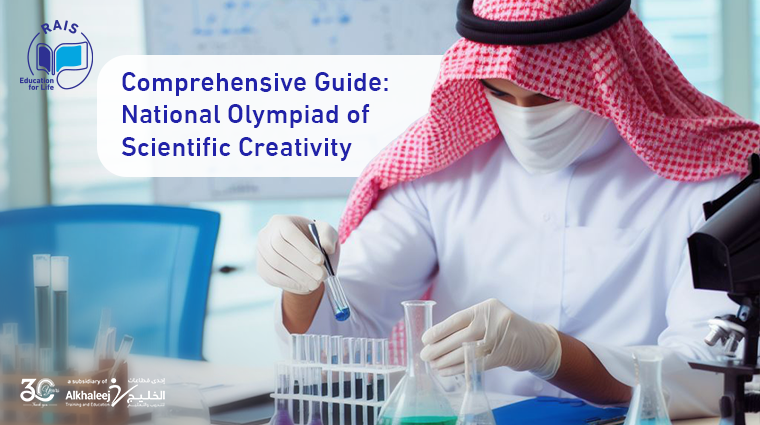
Having an intelligent and science-loving child is wonderful, but it is not without responsibility. His passion needs guidance and management, in order to emerge in the right direction
To do this in the right way, either you, as a parent, resort to strict educational methods or to interactive competitions that make the learning process itself fun and motivating enthusiasm!
As a contest of the National Olympiad of Scientific Creativity!
What is the competition of the National Olympiad of Scientific Creativity?
The National Olympiad competition for Scientific creativity is one of the most important individual scientific competitions in Saudi Arabia, which is organized annually for students in the middle and secondary stages, in which competitions in various scientific fields are organized individually and judged electronically.
Besides being in presence through a jury composed of a selection of specialized academics.
What are the areas of competition in the contest of the National Olympiad of Scientific Creativity?
The competition at the Olympiad of Creativity is organized in different scientific branches, so the student can participate with his project in any of the following scientific fields:
– Biochemistry (BCHM)
– Computational biology and informatics (CBIO)
– – Plant Sciences (PLNT)
– Mathematics
– Macro Microbiology
– Social and Behavioral Sciences (BEHA)
– Software Systems (SOFT)
– Biomedical Engineering (ENBM)
– Environmental Engineering (ENEV)
– Earth and Environmental Sciences (ENEV)
– Chemistry (Chem)
– Zoology (ANIM)
– Robots and Intelligent devices (ROBO)
– Physics and Astronomy (PHYS)
– Engineering Technologies (ETSD)
– Embedded Systems (EBED)
– Cellular and Molecular Biology
– Biomedicine and Health Sciences (BMED)
– Power (EGSD)
– Selective Medical Sciences (TMED)

What are the conditions for registration in the National Olympiad of Scientific Creativity?
- The participating student must be a Saudi national.
- The student must be enrolled in secondary or middle school.
- The participant shouldn’t be less than 11 and not more than 20 years old.
- Electronic registration by filling out the participation form on Mawhiba website.
- The participating student must be enrolled in one of the schools located in the kingdom of Saudi Arabia.
- The student must choose a supervisor for the registered project according to a set of controls and criteria.
- Personal attendance to participate in all competition events and exhibitions, especially Ebdaa Science and Engineering Fair.
- Compliance with all the rules and conditions of participation in the project approved by the executive committee.
By looking at these conditions, you may have wondered one or two points, such as who is the project supervisor? What are his powers? What information is available about Ebdaa Science and Engineering Fair? Or what are the approved conditions and standards?
All this information we will discuss in detail in our comprehensive guide, no need to worry, let’s start first with the following:
Who is the project supervisor at the Scientific Creativity Olympiad competition?
One of the conditions for registration in the National Olympiad competition for Scientific Creativity is that the student is supported in his project by the so-called Project Supervisor or academic supervisor, and both roles differ in the nature of the tasks assigned to them as well as the conditions for their selection process.
In order to understand together the difference between both names, let’s explain each of them in detail as follows:
Project supervisor
He is a person chosen by the student participating in the Creativity Olympiad competition to be responsible for working on the project with him.
It can be one of his parents, a teacher, a relative, or anyone who has sufficient information to help him support the student participating in the project and familiar with the controls and standards of the competition, provided that the project supervisor meets the following conditions:
- He holds a bachelor’s degree in one of the University specialties.
- The academic supervisor’s specialization should preferably be in the same field as the student’s project.
- Familiar with the special standards and controls organized for the Scientific Creativity Olympiad competition.
The tasks of the project supervisor according to the website of Mawhiba are as follows:
- Review the conditions of participation in the competition, its stages, controls, and standards governing it.
- Assisting and supporting the student project at all stages of the project, starting from planning until coming up with its final form.
- Help the student to choose the name of the project and its field.
- Ensure the possibility of conducting experiments and implementing the engineering design model in a period commensurate with the stages, timing, and competition.
- Assist the student in writing a summary, project plan, reviews, and uploading them on the website.
- Review the display panel for final filtering and ensure the accuracy and correctness of its information.
- Checking that the innovation model does not exceed the specified measurements (length 50 cm, width 40 cm, Height 20 cm).
- Assist the student participating in the application of scientific experiments in laboratories.
- Assistance in the design and implementation of the innovation prototype.
- Coordination with scientific research bodies such as universities and hospitals to apply experiments and studies in scientific laboratories.
- Coordination with scientific, industrial, and technical authorities to implement innovation, if any.
- Assist the participant in filling out the mandatory forms of the project.
- Filling and signing the project supervisor form.
- Review all required forms making sure the date and signature of each form.
Academic supervisor
The academic supervisor is a supervisor who is selected in certain fields in the competition, such as projects related to biological research, histology, blood, microorganisms, scientific disciplines such as medicine and engineering, as well as some behavioral research.
Anyone can be selected provided that the following conditions are met:
- Holds a PhD or Master’s degree in the field of project specialization.
- The person’s experience in the field of specialization should not be less than 3 years.
- Be familiar with the rules and standards of the scientific creativity Olympiad competition.
Considering the above, it may confuse you that there are some projects that require supervisors, but this is not true, the academic supervisor can be the same as the supervisor of the project provided that the previous conditions agree with it, with the possibility that the person is the supervisor of more than one project for the competition.
It is forbidden to be one of the members of the jury or the review committee of human elements projects or the one who approves the approval letter.
The tasks of the academic supervisor in the project according to Mahiba website are as follows:
- Review the conditions of participation and scientific ethical controls.
- Assist the participant with any scientific sources and information in the field of specialization.
- Review and approve the project plan in the scientific aspect.
- Correct any specialized scientific errors in the project plan and display panel.
- Familiarizing the participant with the controls and procedures of security and safety in laboratories and achieving the participant’s understanding of all the steps of the experiment.
- Carrying out dangerous biological or chemical experiments that the participant cannot perform in the laboratory.
- Appoint a designated supervisor in case he is not in presence with the participating student while conducting experiments in the laboratory.
- Fill out the academic supervisor form and sign it.
- Fill out the form of the approved research body in case experiments were conducted in it.
- Fill out any other forms if requested.
What is Ebdaa Science and Engineering Fair and its relationship to the Olympiad competition Scientific Creativity?
Ebdaa Science and Engineering Fair is one of the exhibitions to be visited by the students participating in the National Olympiad Competition for Scientific Creativity.
In which a huge exhibition is organized to select the best projects submitted by students to represent the kingdom of Saudi Arabia at international exhibitions and competitions.
In addition to providing valuable prizes to the winners in the presence of important national figures.
What are the conditions for participation in the National Olympiad of Scientific Creativity?
So far, the word of the rules and conditions of participation in the creativity Olympiad competition has been repeated in front of you more than once.
It is natural if you are interested in your son’s participation in this kind of huge competitions, to research and find out what the nature of these conditions is; and since this is a comprehensive guide to everything related to:
- The participating student is entitled to only one project.
- Registration on the site with a group project is prohibited.
- Participation in the same project between more than one student is prohibited and if, both projects are canceled.
- Complete the full registration stages, which consist of:
– Registration of personal information.
– Project information.
– Raising the scientific project models at the second stage.
– Uploading bank statements
– Print the deposit card to attend the exhibitions of the educational districts, the central exhibitions, and Ebdaa Science and Engineering Exhibition when the project is qualified.
- Fill in the project information and in the project summary and plan.
- Projects in which information about them has not been recorded are excluded.
- The executive committee has the right to exclude projects for which scientific background information is not available in the project summary.
- The executive committee has the right to exclude projects in which the project title does not coincide with the project summary.
- The executive committee has the right to exclude a participant who has entries in other competitions that coincide with the stages of the competition.
- The participating student is not allowed to change the field of the project after the end of the arbitration period.
- The project must be an original project or developed from a previous project.
- It’s not allowed to change the name of the project supervisor after registering his name on the talent website.
- Adherence to scientific ethical controls in the implementation of projects and conducting experiments.
- Fill in all required work forms.
- Do not exceed the required sizes in the case of engineering models.
- In the case of completing a project from last year, this should be clarified during the interview with the jury. Fill out Form 7 on Mawhiba website and just write down the new or developed part of the project.
Registration for the Olympiad Competition of Scientific Creativity is held annually from August to September. It is carried out in the period from October to May, provided that the implementation period takes place in 6 stages as follows:
– The first stage is the registration of student information and training lectures for students and supervisors.
– The second stage is registration of the project information and doing it electronically on Mawhiba website and exhibitions of educational areas.
– The third stage is electronic judging, announcement of candidates for the central exhibitions, and uploading a deposit form on Mawhiba website.
– The fourth stage is Central exhibitions and training workshops in the governorates, the announcement of the qualifiers for the Ebdaa Science and Engineering Fair, and uploading the information of participants’ projects on the website.
– The fifth stage involves participation in the Ebdaa Science and Engineering Fair.
– The sixth stage is the qualifying workshop for the international participation of Taicf, the international participation of Taicf in Taiwan, the qualifying program for the international participation of AICF, and the international participation of the AICF in the USA.
The qualifying workshop for the international participation of Aitex, the international participation of the Aitex in Malaysia.

What is the ISEF International Science and Engineering Fair?
The ISEF International Exhibition differs from the local Ebdaa Science and Engineering Exhibition; the former is the largest competitive scientific exhibition in the field of scientific research for the pre-university stage.
In which more than 75 countries around the world are hosted annually and the event is organized under the auspices of the American Society for Science & the public Foundation, and the kingdom of Saudi Arabia has been participating since 2007 until now.
Are there facilities for conducting experiments in laboratories?
Yes, the scientific committee of the National Creativity Olympiad Competition provides special facilities for participating students to enter scientific laboratories.
Taking care that the participants follow all the ethical and scientific standards and controls followed when performing these experiments.
What forms should be filled in at the National Olympiad of Scientific Creativity?
There are a set of forms and papers that the participant must fill in if the project is submitted, some of them are general and must be available in all projects, and some are limited only to the nature of some scientific projects, and these forms vary as follows:
1- Review form for the Adult Sponsor checklist project supervisor:
It is called Form 1, which is mandatory for all projects, and in it the information is filled in by the supervisor of the project in cooperation with the participating student.

2- Review form for the student Checklist participant
It is called Form 1A and it is mandatory for all projects as well, in which the information is filled in by the participating student, and special instructions are attached to write the project plan.
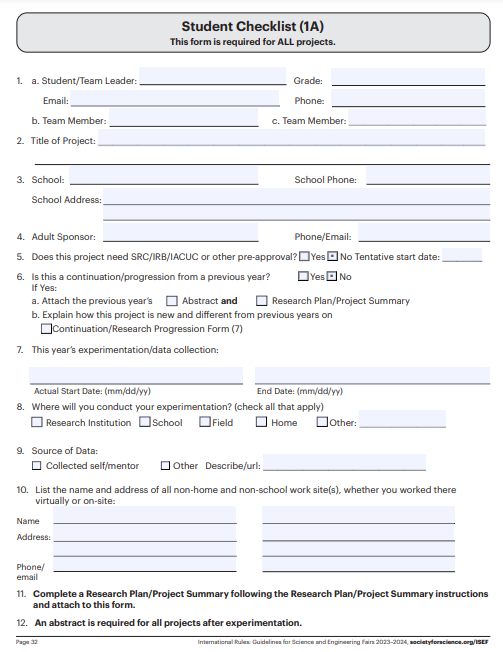
3- Project plan (Research Plan Instructions):
It is also called the project plan, which is mandatory for all projects and is written by the participating student with the follow-up from the supervisor, and is delivered with Form 1A.
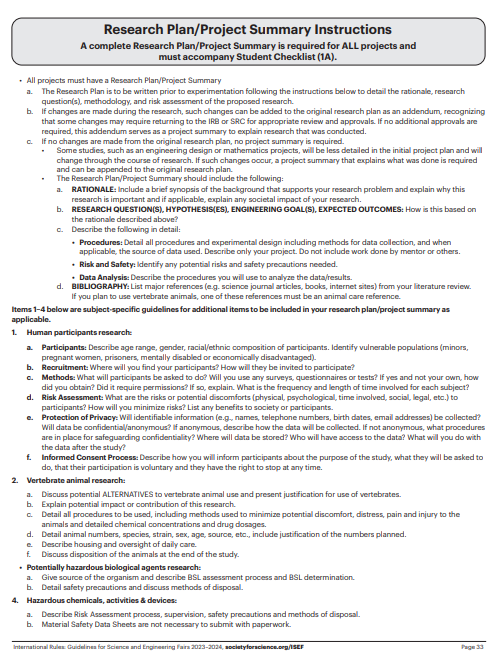
4- Approval Form
It is called Form 1B and it is mandatory for all projects and the upper part is filled by the participating student and his guardian, and the lower part by the SRC committee.

5- Abstract Form project summary
The project summary is named after him, in which the information is filled in by the participating student under the auspices of his supervisor and is mandatory for all projects.
6- Approved research institutional/Industrial setting form
It is called the 1C form, which is special for projects that require experiments in research centers, laboratories, hospitals or any accredited entity, and is filled in by the supervisor of the project.
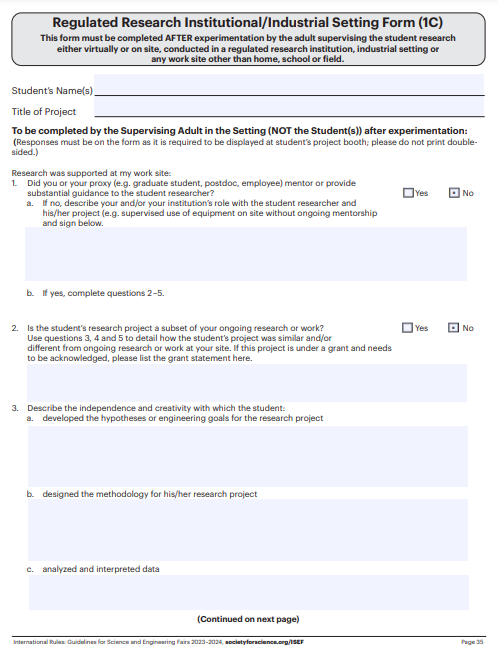
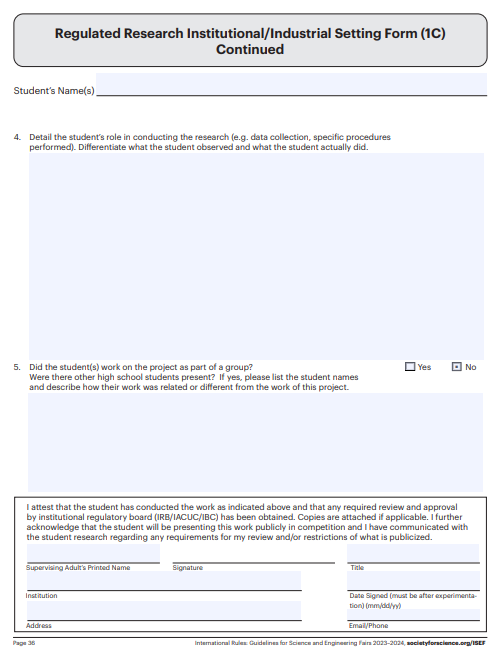
7- Qualified Scientist Form
It is called Form 2 and it is special for projects where the presence of a specialized academic supervisor is required, and it is filled by him.

8- Risk Assessment form
It is called Form 3 and is for laboratory or scientific experiments in which hazardous chemicals or tools are used or activities requiring special protective measures are carried out, and it is filled out by the participant.

9 – Human Subject Form
It is called Form 4 and the upper part of it is filled in by the participant before the start of experiments on human elements in case the project requires it, and the lower part is accepted by the human elements Projects Review Committee.

10- Human Informed Consent form
It is filled by the participants themselves if they are 18 years old or older, and by their parents if they are younger.

11- Vertebrate Animal Form – Unofficial
It is called Form 5A and is filled in before the start of experiments on vertebrate animals in informal bodies such as home or school. It is a form divided into 3 parts, the upper part is filled in by the participant, the middle part by the SRC Committee, and the lower part by the veterinarian and academic supervisor of the project.

12- Vertebrate Animal Form – Approved research bodies
It is called Form 5B and it is filled in before the start of conducting experiments in the project.
It is divided into two parts, the upper part is filled in by the participant, and the lower part by the academic supervisor or government official in the official entity with a copy of the letter of credit from the government entity that granted approval.
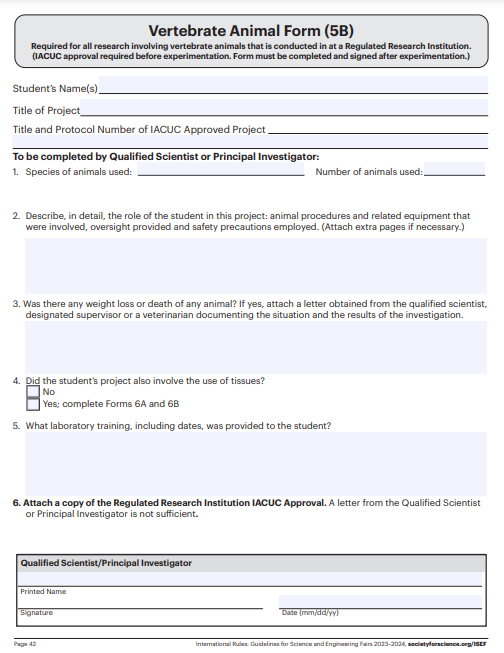
13- Potentially Hazardous Biological Form
It is called Form 6A and was filled in before the start of conducting experiments that have a risk ratio in their performance. In which the data for the upper part is filled in by the student and the academic supervisor in case the experiment was on microorganisms, nucleic acids, living or frozen tissues, blood or fluids. the middle part by the academic supervisor, and the last by the SRC committee.
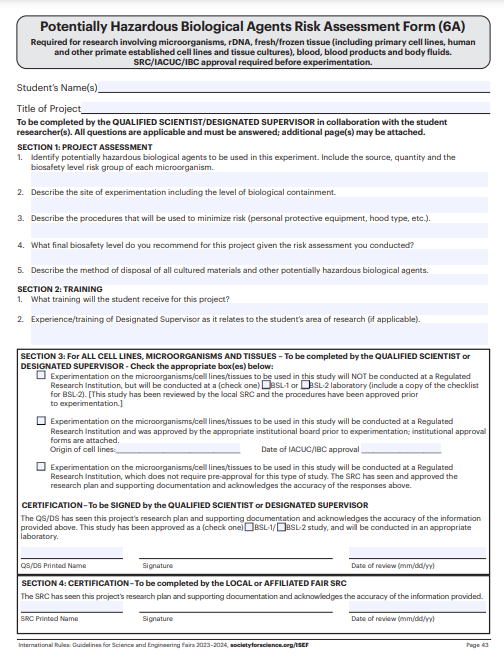
14- Human & Vertebrate animal tissue Form
It is called Form 6B and is specific for projects in which human tissues and vertebrate animals are dealt with. The data of the upper part is filled in by the participating student and the lower part by the academic supervisor before the experiments begin.
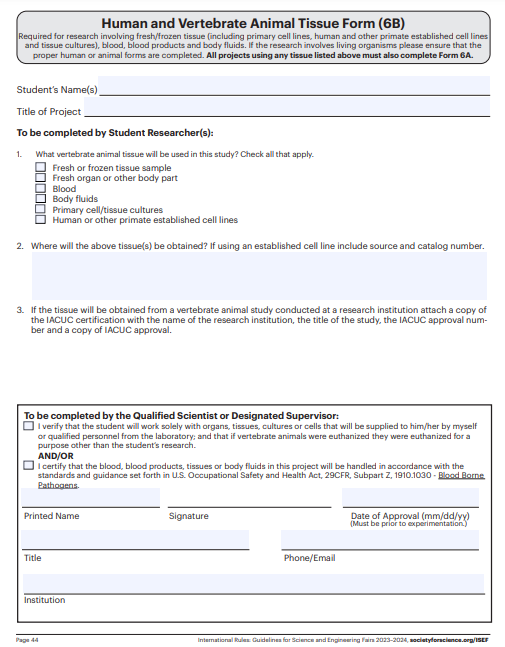
17- Continuation Projects Form
It is called Form 7, which is for ongoing projects from a previous year, in which the project summary and its previous plan are also attached, and it is filled in by the participant.

How do I fill out a form for the National Olympiad of scientific creativity?
The official website Mawhiba provides a comprehensive digital library that contains a full explanation of all the steps, the beginning of the method of filling out forms, their conditions and scientific controls for each project, to clarify the stages of research in projects. In addition to explaining how to formulate the research problem, how to ensure the originality of the idea and specifications of the purpose boards, as well as the method of selecting projects, writing, and submitting them.
When is the judging for the National Olympiad of scientific creativity?
Electronic judging takes place at the fourth stage of the National Olympiad of Scientific Creativity, where candidates for the central exhibitions and those eligible to participate in Ebdaa Science and Engineering Fair are announced.
Concluding this article, we can conclude that the National Olympiad of scientific creativity competition is a valuable opportunity for talented young people to develop their scientific and research skills, get acquainted with talented peers and exchange ideas and knowledge with them, enriching their lives and opening up new horizons in the fields of Science, Technology and knowledge.
